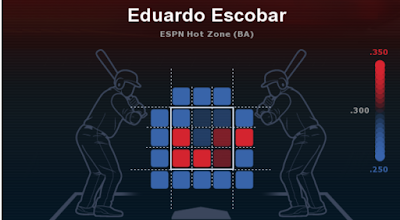Eduardo Escobar Acquisition Could Pay Off Huge Dividends for the Dbacks
Yesterday afternoon, it was officially announced that the Arizona Diamondbacks had acquired versatile infielder/outfielder, Eduardo Escobar, from the Minnesota Twins in exchange of three Class-A prospects. It was certainly a trade that surprised some people, but the Dbacks had been connected to Escobar for a while at varying degrees along with other middle infielders available on the market including Escobar's former teammate, Brian Dozier, and Met's second baseman, Asdrubal Cabrera.
Either way, the acquisition of Eduardo Escobar is one that will likely pay off huge dividends for the Arizona Diamondbacks and could be a move that matches the impact that Manny Machado would have had on the team. Machado is more of a star name compared to Escobar, but when you start to look at the numbers in more depth, you can start to see why Escobar has still been very successful over his big league career at the plate, especially this year, and how he adds some more depth to the Diamondbacks lineup.
So far this season, Escobar has 101 hits, 15 home runs, 63 RBI, and 34 walks over 408 plate appearances. Remember earlier this season when it seemed as though Escobar couldn't stop hitting doubles either and everyone nicknamed him the Doubles Machine? Well, he's also got 35 doubles on the year and is heading to a team that plays in a hitters paradise of a ballpark. Furthermore, Escobar has a .338 on-base percentage, a .514 slugging percentage, and a a Weighted Runs Created Plus (wRC+) value of 125 which all adds up to a 12.0 Offensive rating or a 2.5 Wins Above Replacement (WAR) value.
In addition, Eduardo Escobar has done really well so far this season with runners in scoring position. According to the metrics, Escobar is hitting .390 during those situations, which puts him as the 5th best in all of baseball. Considering how high Escobar ranks in that offensive category, it is easy to see why he has been so successful offensively this season and come through during situations that count the most. At various times throughout this year, the Diamondbacks have needed help during situations that present runners in scoring position, as is the case with any team at various points throughout the season, so Escobar should help in that department.
Beyond that, Escobar has a pretty well balanced offensive game as well in terms of being able to hit the ball to all parts of the field. Consider the graphic below for further illustration of that point.
 |
| From L to R: Pull%, Centerfield%, and Opposite Field % From T to B: 2016, 2017, 2018 |
Beyond that, Escobar has seemingly changed his approach when it comes to hitting within the zone and where he makes the most contact. Here is a chart showing his Hot Zones for this year:
Compare that to Escobar's Hot Zone chart for the 2017 season shown below:
As you can see, the differences aren't significant, but Escobar has started to hit higher up in the zone this season compared to last year. In addition, it would appear as though his swing is traveling through the lower part of the zone less and compared to last season, it doesn't look like it goes outside the zone much. For instance, look at the bottom chart and observe the 2nd square on the right side of the zone, it's red. That's not the case for the chart, from this season, which has Escobar swinging at an average to below average rate, in all areas outside of the zone.
While it's important to realize how good of a hitter Escobar has been this year during his age 29 season, it's also important to look at how he has done in the past. After all, you can't make an accurate judgment about any big league hitter unless you have current data to compare to previous data. Escobar has never been known for being one of the power hitters in baseball, but rather more of an on-base and situational hitting guy, which is one reason why some teams were serious about pursuing him prior to Tuesday's trade deadline.
Dating back to the start of the 2016 regular season, Escobar has 42 home runs, 173 RBI, a .310 on-base percentage, and a slugging percentage of .436 over the span of 1,284 plate appearances. Furthermore, over that span, Escobar has a Weighted On-Base Average (wOBA) of .317 along with a Weighted Runs Created Plus (wRC+) value of 95. Given the talent and depth at Escobar's primary position, third base, he doesn't rank up high on the list in any of those offensive categories, but he still has been very effective and does enough offensively to alter the look of any team's lineup.
For the Diamondbacks, that alteration will likely come in a big way as Eduardo Escobar lengthens the team's lineup and is a, more than capable replacement for the offensive production, lost with the absence of Jake Lamb. Although Escobar is poised to hit free agency this winter, who knows what the long term future of this move holds. The Diamondbacks might have just found their new primary third baseman, who has the ability to play second base, shortstop, and in the outfield as well, if all works out and Escobar doesn't cost too much in the offseason. If not, then the Diamondbacks will certainly be appreciative of all offensive contributions that Escobar brings to the park on a daily basis, as they look to win the NL West and fend off the Los Angeles Dodgers and Colorado Rockies, in their pursuit of a division championship.





Comments
Post a Comment